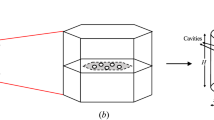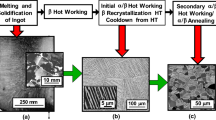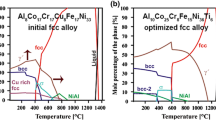Abstract
This article presents a microstructure-based multistage fatigue (MSF) model extended from the model developed by McDowell et al.[1,2] to an A380-F aluminum alloy to consider microstructure-property relations of descending order, signifying deleterious effects of defects/discontinuities: (1) pores or oxides greater than 100 μm, (2) pores or oxides greater than 50 μm near the free surface, (3) a high porosity region with an area greater than 200 μm, and (4) oxide film of an area greater than 10,000 μm2. These microconstituents, inclusions, or discontinuities represent different casting features that may dominate fatigue life at stages of fatigue damage evolutions. The incubation life is estimated using a modified Coffin–Mansion law at the microscale based on the microplasticity at the discontinuity. The microstructurally small crack (MSC) and physically small crack (PSC) growth was modeled using the crack tip displacement as the driving force, which is affected by the porosity and dendrite cell size (DCS). When the fatigue damage evolves to several DCSs, cracks behave as long cracks with growth subject to the effective stress intensity factor in linear elastic fracture mechanics. Based on an understanding of the microstructures of A380-F and A356-T6 aluminum alloys, an engineering treatment of the MSF model was introduced for A380-F aluminum alloys by tailoring a few model parameters based on the mechanical properties of the alloy. The MSF model is used to predict the upper and lower bounds of the experimental fatigue strain life and stress life of the two cast aluminum alloys.





Similar content being viewed by others
Notes
The terms “inclusion” or “inclusion/discontinuity” will be used from this point to describe the feature concerned: constituent particles, oxide films, or pores.
References
D.L. McDowell, J. Fan, M.F. Horstemeyer: AFS Trans., 1999, vol. 109, pp. 703–12
D.L. McDowell, K. Gall, M.F. Horstemeyer, J. Fan: Eng. Fract. Mech., 2003, vol. 70, pp. 49–80
J. Fan, D.L. McDowell, M.F. Horstemeyer, K. Gall: Eng. Fract. Mech., 2001, vol. 68, pp. 1687–1706
K. Gall, M.F. Horstemeyer, D.L. McDowell, J. Fan: Mech. Mater., 2000, vol. 32, pp. 277–301
K. Gall, N. Yang, M.F. Horstemeyer, D.L. McDowell, and J. Fan: Metall. Mater. Trans. A, 1999, vol. 30A, pp. 3079–88
K. Gall, N. Yang, M.F. Horstemeyer, D.L. McDowell, and J. Fan: Fatigue Fract. Eng. Mater. Struct., 2000, vol. 23, pp. 159–72
H. Naitani and M. Goto: in The Behavior of Short Fatigue Cracks, K.J. Miller and E.R. de los Rios, eds., Mechanical Engineering Publishers, London, 1987, pp. 461–78
K. Shiozawa, Y. Tohda, S. Sun: Fatigue Fract. Eng. Mater. Struct., 1997, vol. 20, pp. 237–47
M.F. Horstemeyer: Scripta Mater., 1998, vol. 39 (11), pp. 1491–95
Y. Xue, D.L. McDowell, M.F. Horstemeyer, M.H. Dale, and B.J. Jordon: Eng. Fract. Mech., 2007, in press
Y. Xue, H. El Kadiri, M.F. Horstemeyer, J.B. Jordon, and H. Weiland: Acta Mater., 2007, vol. 55, pp. 1975–84
Y. Xue, M.F. Horstemeyer, D.L. McDowell, H. El Kadiri, and J. Fan: Int. J. Fatigue, 2007, vol. 29, pp. 666–76
H. El Kadiri, Y. Xue, M.F. Horstemeyer, B. Jordan, P. Wang: Acta Mater., 2006, vol. 54, pp. 5061–76
D.R. Hayhurst, F.A. Leckie, D.L. McDowell: ASTM STP, ASTM, Philadelphia, PA, 1985, pp. 688–99
D.L. McDowell: Int. J. Fract., 1996, vol. 80, pp. 103–45
J.C. Newman: Fatigue Fract. Eng. Mater. Struct., 1994, vol. 17, pp. 429–39
M.M. Makhlouf, D. Apelian, L. Wang: Microstructures and Properties of Aluminum Die-Castings, North American Die Castings Association, Rosemont, IL, 1998, pp. 71–73
Acknowledgments
The Mississippi State University authors express appreciation for the support of the Center for Advanced Vehicular Systems, Mississippi State University. One of the authors (DLM) is grateful for the support of the Carter N. Paden, Jr. Distinguished Chair in Metals Processing at Georgia Tech.
Author information
Authors and Affiliations
Corresponding author
Additional information
This article is based on a presentation made in the symposium entitled “Simulation of Aluminum Shape Casting Processing: From Design to Mechanical Properties,” which occurred March 12–16, 2006 during the TMS Spring Meeting in San Antonio, Texas, under the auspices of the Computational Materials Science and Engineering Committee, the Process Modeling, Analysis and Control Committee, the Solidification Committee, the Mechanical Behavior of Materials Committee, and the Light Metal Division/Aluminum Committee.
Rights and permissions
About this article
Cite this article
Xue, Y., Burton, C.L., Horstemeyer, M.F. et al. Multistage Fatigue Modeling of Cast A356-T6 and A380-F Aluminum Alloys. Metall Mater Trans B 38, 601–606 (2007). https://doi.org/10.1007/s11663-007-9062-1
Published:
Issue Date:
DOI: https://doi.org/10.1007/s11663-007-9062-1




